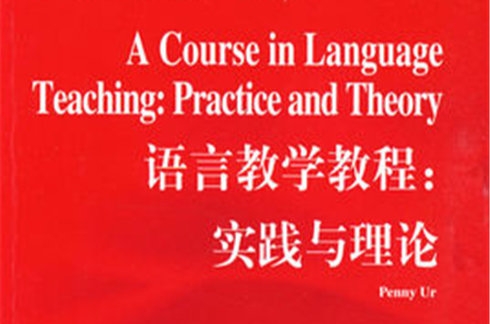內容簡介
《語言教學教程:實踐與理論》內容簡介:在編輯這個文庫時,我們在兩方面下了功夫。一方面,在選書時,我們求全,求新,求有代表性和前瞻性。我們不偏愛一家之言,也不只收一家外國出版社之書。語言學與套用語言學的主幹學科固然受到了應有的重視,分支學科可也不忽視。語料語言學、語言統計學是新興學科,我們收入了專著;句法學、語義學久已有人研究,我們也找到了有關的最新著作。
另一方面,我們邀請了國內知名的博士生導師、碩士生導師為各書撰文導讀,為讀者鋪平道路。語言學和套用語言學專著包羅宏富,初學者讀起來可能覺得茫無頭緒。為了助他們一臂之力,本文庫中每一種書我們都請專家寫了一萬字左右的導讀材料。哪怕書中內容比較陌生,誰只要在讀書前看一下導讀材料,讀書後把材料再看一遍,一定能弄清脈絡,掌握要點。
目錄
Units with a symbol are components of the 'core' course; those with a symbol are 'optional'
Preface by Halliday
王宗炎序
導讀
Acknowledgements
Read this first: To the (trainee) teacher To the trainer
Introduction
Part I The teaching process
Module 1: Presentations and explanations
Unit One: Effective presentation
Unit Two: Examples of presentation procedures
Unit Three: Explanations and instructions
Module 2: Practice activities
Unit One: The function of practice
Unit Two: Characteristics of a good practice activity
Unit Three: Practice techniques
Unit Four: Sequence and progression in practice
Module 3: Tests
Unit One: What are tests for?
Unit Two: Basic concepts; the test experience
Unit Three: Types of test elicitation techniques
Unit Four: Designing a test
Unit Five: Test administration
Part II Teaching the language(1)The'what'
Module 4: Teaching Pronunciation
Unit One: What does teaching pronunciation involve?
Unit Two: Listening to accents
Unit Three: Improving learners' pronunciation
Unit Four: Further topics for discussion
Unit Five: Pronunciation and spelling
Module 5: Teaching vocabulary
Unit One: What is vocabulary and what needs to be taught?
Unit Two: Presenting new vocabulary
Unit Three: Remembering vocabulary
Unit Four: Ideas for vocabulary work in the classroom
Unit Five: Testing vocabulary
Module 6: Teaching grammar
Unit One: What is grammar?
Unit Two: The place of grammar teaching
Unit Three: Grammatical terms
Unit Four: Presenting and explaining grammar
Unit Five: Grammar practice activities
Unit Six: Grammatical mistakes
Module 7: Topics, situations, notions, functions
Unit One: Topics and situations
Unit Two: What ARE notions and functions?
Unit Three: Teaching chunks of language: from text to task
Unit Four: Teaching chunks of language: from task to text
Unit Five: Combining different kinds of language segments
Part III Teaching the language(2):The'how'
Module 8: Teaching listening
Unit One: What does real-life listening involve?
Unit Two: Real-life listening in the classroom
Unit Three: Learner problems
Unit Four: Types of activities
Unit Five: Adapting activities
Module 9: Teaching speaking
Unit One: Successful oral fluency practice
Unit Two: The functions of topic and task
Unit Three: Discussion activities
Unit Four: Other kinds of spoken interaction
Unit Five: Role play and related techniques
Unit Six: Oral testing
Module 10: Teaching reading
Unit One: How do we read?
Unit Two: Beginning reading
Unit Three: Types of reading activities
Unit Four: Improving reading skills
Unit Five: Advanced reading
Module 11: Teaching writing
Unit One: Written versus spoken text
Unit Two: Teaching procedures
Unit Three: Tasks that stimulate writing
Unit Four: The process of composition
Unit Five: Giving feedback on writing
Part IV Course content
Module 12: The syllabus
Unit One: What is a syllabus?
Unit Two: Different types of language syllabus
Unit Three: Using the syllabus
Module 13: Materials
Unit One: How necessary is a coursebook?
Unit Two: Coursebook assessment
Unit Three: Using a coursebook
Unit Four: Supplementary materials
Unit Five: Teacher-made worksheets and workcards
Module 14: Topic content
Unit One: Different kinds of content
Unit Two: Underlying messages
Unit Three: Literature (1): should it be included in the course?
Unit Four: Literature (2): teaching ideas
Unit Five: Literature (3): teaching a specific text
Part V Lessons
Module 15: Lesson planning
Unit One: What does a lesson involve?
Unit Two: Lesson preparation
Unit Three: Varying lesson components
Unit Four: Evaluating lesson effectiveness
Unit Five: Practical lesson management
Module 16: Classroom interaction
Unit One: Patterns of classroom interaction
Unit Two: Questioning
Unit Three: Group work
Unit Four: Individualization
Unit Five: The selection of appropriate activation techniques
Module 17: Giving feedback
Unit One: Different approaches to the nature and function of feedback
Unit Two: Assessment
Unit Three: Correcting mistakes in oral work
Unit Four: Written feedback
Unit Five: Clarifying personal attitudes
Module 18: Classroom discipline
Unit One: What is discipline?
Unit Two: What does a disciplined classroom look like?
Unit Three: What teacher action is conducive to a disciplined classroom?
Unit Four: Dealing with discipline problems
Unit Five: Discipline problems: episodes
Part VI Learner differences
Module 19: Learner motivation and interest
Unit One: Motivation: some background thinking
Unit Two: The teacher's responsibility
Unit Three: Extrinsic motivation
Unit Four: Intrinsic motivation and interest
Unit Five: Fluctuations in learner interest
Module 20: Younger and older learners
Unit One: What difference does age make to language learning?
Unit Two: Teaching children
Unit Three: Teaching adolescents: student preferences
Unit Four: Teaching adults: a different relationship
Module 21: Large heterogeneous classes
Unit One: Defining terms
Unit Two: Problems and advantages
Unit Three: Teaching strategies (1): compulsory + optional
Unit Four: Teaching strategies (2): open-ending
Unit Five: Designing your own activities
Part VII And beyond
Module 22: And beyond
Unit One: Teacher development: practice, reflection, sharing
Unit Two: Teacher appraisal
Unit Three: Advancing further (1): intake
Unit Four: Advancing further (2): output
Trainer's notes
Bibliography
Index
文庫索引

